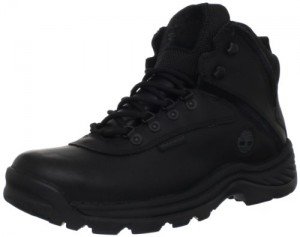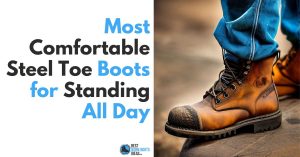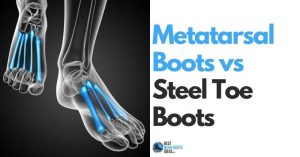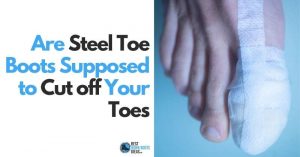What Type of Footwear Protects Your Entire Foot? Your Complete Safety Guide to Keeping Your Feet in One Piece
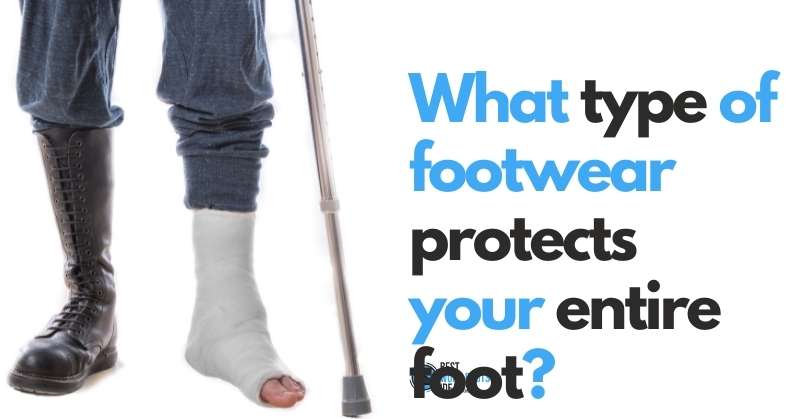
There is no single feature or style of footwear that can protect your entire foot from injury.
Even with that being the case, it’s absolutely possible to protect your feet from any and all dangers if you know what PPE features are available and what you need.
Below, I’m going to discuss these features and how to combine them properly to keep your foot in one piece.
Contents
What Type of Footwear Protects Your Toes From Falling Objects and Being Crushed?
Safety toe footwear is the style to prevent your toes from being smashed, crushed, or otherwise injured. It’s not uncommon to hear this style referred to as “steel toe boots,” but this title is a little misleading and not always entirely accurate.
Most work boots and some hiking boots are designed and constructed with an ASTM f2413-rated toe cap.
This toe cap can be made of a number of materials, but is divided into 3 categories: steel, alloy, and composite.
If you’re interested in the specifics about how toe caps keep your toes safe, check out my earlier article.
Just for your clarity, it’s not uncommon for people, particularly construction workers, particularly construction veterans to refer to all protective boots as steel toe boots.
What Type of Footwear Protects the Instep or the Top of the Foot?
Metatarsal boots are a style of protective footwear that extends protection of the toe cap to the top of the foot. In recent years, manufacturers have begun making boots with a metatarsal guard embedded inside or externally affixed as opposed to a separate accessory as in the past.
This style is growing in popularity as the protection offered by traditional toe caps is somewhat limited.
Wearing a Metatarsal shoe aims to protect your metatarsal bones, hence the name.
Just be mindful that a met guard does not protect the entire toe area. In order to achieve that, you’ll need to ensure you have a toe cap.
It’s a good idea to also familiarize yourself with the difference between metatarsal and steel toe boots so you understand how they both protect you.
I’ve watched quite a number of videos of people testing toe caps by wearing a safety boot and having someone run it over with a vehicle.
Smart?
No.
Stupid?
Incredibly.
What I’m getting to, is that every time I watch one of these, I’m nervous for the person.
Not because I don’t trust toe caps, I do, it’s just that there’s such a small amount of clearance between where the tire of the vehicle is and where the toe cap ends.
Many workers, employers, and safety boot manufacturers must have felt the same way, because it’s easy to look at any of the top work boot brands and find a reliable pair of metatarsal boots in their product catalogs.
What Type of Footwear is Appropriate for Cold Conditions?
Grabbing a pair of insulated boots is crucial for anyone working in colder or even moderate climates. The most popular and well known boot insulation is 3M’s Thinsulate, but any modern material should make sure you’re not feeling frigid or frostbitten while on the job.
There is a rating system for Thinsulate, so make sure you’re clear on whether a boot is good for a brisk Ohio morning or the depths of a Minnesota Winter.
Being from coastal New Jersey and owning an residential construction company that did plenty of work outside, I always had a pair of insulated work boots.
Although not as crucial as the insulation, it’s wise to keep in mind what material the toe cap and shank are made of.
Metals will conduct cold temperatures, so if you’re in the colder areas of the country (or world), it’s probably a good idea to grab a composite toe boot for your winter wear.
All this is assuming you’re dealing with reasonably cold temperatures. If you’re somewhere that’s truly arctic, go straight for a pair of bunny boots.
Canadians, Alaskans, and other norther US citizens know all about bunny boots and how useful they are for the worst and coldest weather.
What Type of Footwear Protects the Bottom of Your Foot from Puncture and Penetration?
Puncture resistant footwear is the only option when it comes to protecting the sole of your foot from unwanted cuts and stabs. There are a variety of options of material and location within the boots to imbed that material.
Sometimes you’ll find the protective material is steel, others you’ll find advanced aramid fiber materials like Kevlar and Lenzi.
Again, sometimes you’ll find the protection is embedded within the midsole, other times it will be located in the insole or even the footbed!
I don’t remember which article, but I’ve discussed how there are only two types of construction workers: those that have stepped on a nail, and those that haven’t stepped on a nail yet.
Puncture resistance is absolutely crucial for anyone in carpentry, demolition, and most larger construction projects where the worksites are littered with materials that will pierce regular rubber or TPU with ease.
If you’re in the emergency services such as a firefighter, then you’ll also need underfoot protection.
What Type of Footwear Protects You from Chemicals and Provides Extra Traction on slippery floors?
Slip, oil, and chemical resistant outsoles are widely available features from most work boot brands.
Keep in mind, they are not interchangeable terms, and something can be slip resistant without being chemical resistant.
It’s also extremely important to remember that if you’re trying to stay safe from chemicals at work, there’s more you can do besides outsoles.
Some boots feature tall throats and chemical resistant uppers that will allow you to handle contact with harmful materials without paying the price with your health.
This isn’t to say you should go romping around the Springfield Nuclear Power Plant, but you’re definitely safer
How Can One Improve Foot Safety in Workplaces Where Foot Injuries Occur Frequently?
Protective footwear should be specifically catered to the person wearing it. When buying, it’s most important to know the conditions that you’ll be working in. While certain protective features are great for some jobs, they’re downright dangerous for others.
It’s important to know what you need for your work, not someone else’s.
When looking at different footwear options, weigh the likelihood of different situations occurring.
What exactly do I mean by that?
Good question.
Let’s say I’m working at a factory.
The likelihood of me needing boot outsoles with deep lugs, an aggressive tread pattern, and a 90 degree heel to secure my footing is pretty low.
There is nothing particularly unsafe about these features, and to someone working outdoors on rough surfaces, they are the boot features to look for.
It’s impossible and foolish to assume that the physical world will conform to our wishes; in reality, it’s the other way around.
Pretending that this isn’t true is a quick way to get injured or even killed.
If you need another example, consider the differences between the wedge boots worn by ironworkers and boots worn by linemen and loggers.
As I detailed in my ironworker article, they wear wedge boots because the flat outsoles give good surface contact and prevent getting caught on any obstacles.
Wear flat bottom, lug-less footwear while climbing a tree or pole, you’re probably crashing to earth within 20 minutes .
Conversely, suit up an ironworker in some logger boots and they will lack the surefootedness, and mobility necessary to work in tight spots and great heights.
This goes to show that the perfect boots for one person would be a nightmare for someone else.
Know your worksite(s), know your needs, and know about the parts of a work boot.
Wrapping Up My Hot Tips
I’ve said it a million times: safety means something different to everyone. There’s no magic pill for happiness nor is there a single boot that will protect your entire foot.
What’s the most beautiful piece of music ever written?
What’s the best city in America?
What’s the most protective boot?
Ask these types of questions and you’re going to find an array of different answers depending on who you’re talking to.
I’m not trying to be snarky, or discouraging to people that want to keep their feet safe.
I’m just trying to get you asking the right questions so you can be as safe as possible.
As always, I encourage you to speak to your HR or Line Manager to understand the most appropriate personal protective equipment (PPE) you need for the job.
Once you know the minimum requirements, you’ll understand the proper footwear you need and can take it from there.

